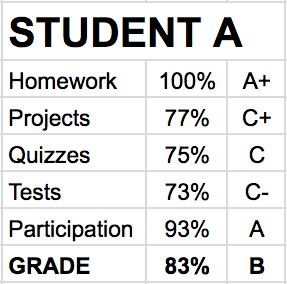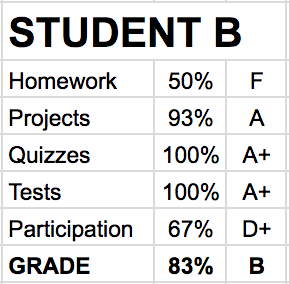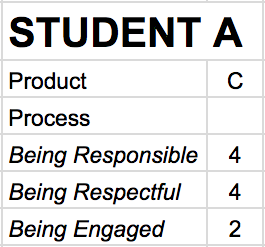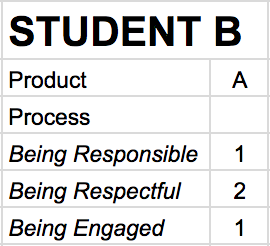Getting Rid of the Singular Grade in Middle School: Separating Product from Process 在中學脫離單一分數:由學習過程中區分出學習成果
For decades, schools have been giving out singular grades for student performance in a course.
“How did you do in geometry this year?”
“A-.”
“Are you good at English?”
“Well, I got a B in LA this year. “
幾十年來,學校一直依學生的表現提供每個課程的單獨分數。
甲∶「今年的幾何你學得怎麼樣?」
乙∶「我得了A-。」
甲∶「你的英文很好嗎?」
乙:「嗯……今年的語言藝術課,我只得到B。」
But often these scores aren’t truly reflective of what’s going on in terms of learning. This year, based on extensive research and keeping up with the latest in best grading practices, MAK’s middle school students and parents will experience a change in our reporting system: the separation of product scores from process scores.
這些分數並不能真實地反映出學習上的情況。今年,基於額外的研究與不斷地以最新的評分系統的演練,馬禮遜的國中部的學生與家長們都將體驗我們新的成績評估系統—從學習過程的分數中區分出學習成果的分數。
When I taught in the humanities before becoming a principal, my gradebook typically looked something like what is listed below. This is a typical gradebook setup for more traditional American secondary teachers.
Homework 20%
Projects 30%
Quizzes 20%
Unit Tests 15%
Participation 15%
在成為校長以前,我是個教人文學科的老師。我的評分表通常如下所示。這也是多數的傳統美國中學教師的典型評分設定。
作業 20%
計畫 30%
小考 20%
單元測試(大考) 15%
課堂參與 15%
It’s no doubt a familiar scenario. And many of us certainly remember, in our own schooling, figuring out how to manipulate the system. Let’s consider a scenario.
毫無疑問地,這是相當熟悉的情況。我們許多人都一定記得,在我們自己的學校教育中,都知道如何使用這系統。讓我們來想想下面的情況:
Student A knows early on in his algebra class that he is going to struggle a bit. Naturally, he goes to the syllabus and figures that he can pad his grade with perfect participation and homework scores, which are a high percentage of the grade, allowing him the room, despite lots of studying, to struggle through a couple quizzes and bomb a test. Say he ends up with a B in the course. A friend of his in the same course is brilliant in math. But she isn’t so great with her homework or participation. For the sake of argument, let’s say that she, too, ends up with a B, and then let’s consider the following grade breakdowns, based on the category weights above.
學生A早就知道上代數課時,他會有點辛苦。自然而然地,他去看了教學大綱,然後計算了一下,他可以用佔總分比重相當高的課堂參與分數及作業成績,有效地拉高他的總分,所以儘管在許多的學習中,一些小考和測驗讓他吃足了苦頭,他卻不需要因為低分而認真唸書。最後,他得到了B。他的另一個朋友也上了這堂課,他的朋友在數學方面相當聰明。可是她的作業和參與分數並不是很好。為了產生爭議,我們就設定她也是在最後得到了B。我們來想一想,以上述分類比重所做的成績細目。
Which of these two students is more accomplished in algebra? Which of these two students is likely a more disciplined and engaged student? The differences are quite apparent here, and clearly one overall grade on a report card does not accurately portray what is going on.
這兩位學生,哪一位在代數的學習成就度比較高呢?哪一位學生比較像守紀律與參與度高的學生?這裡的差距相當明顯,而成績單上的單一整體成績顯然無法準確地描述發生過什麼事。
In a compelling analogy, Thomas R. Guskey, an expert on best practices in grading and reporting, states the following:
舉個令人心服口服的比喻。湯瑪斯蓋斯凱(Thomas R. Guskey)是位評分與報告的最佳實踐專家,他指出:
“If someone proposed combining measures of height, weight, diet, and exercise into a single number or mark to represent a person’s physical condition, we would consider it laughable. How could the combination of such diverse measures yield anything meaningful? Yet every day, teachers combine aspects of students’ achievement, attitude, responsibility, effort, and behavior into a single grade that is then recorded on a report card – and no one questions it.”
「假若一個人提議將身高、體重、飲食及運動量以單一數字整合測量或標記,作為代表一個人的生理狀況,我們會認為這很可笑,怎麼能將這些不同類別的測量值結合成有意義的東西呢?但是日復一日,老師卻將學生們的學習成就、態度、負責任、努力、以及行為通通放進同一個分數裡,然後記錄在成績單上,居然沒有人對此有疑問。」
In the scenarios above, we see this hodgepodge, to use Guskey’s term for it, at work. In the case of Student A, what should be communicated to parents is that the student is truly struggling with the key concepts of the course – and needs help! – but doing an excellent job in work habits and participation. Conversely, Student B’s parents should be told that she has a brilliant mind when it comes to algebra but that her learning habits are incredibly poor – something that may have serious consequences as the material increases in difficulty.
在上述的情況中,以蓋斯凱的術語來說,這稱之為工作上的大雜燴。學生A的案例中,應該與家長溝通的是,學生真的對於課程的重要概念很痛苦也很掙扎,他需要幫忙,不過他卻在作業習慣與參與度上真的做得非常好。相反地,老師應該告訴學生B的家長,學生B上代數課時真的很聰明,可是她的學習習慣卻驚人地差。因為學習材料的難度增加會造成某些嚴重的後果。
Now at MAK, typically our staff do an incredible job of communicating this more detailed information to parents, usually through comments and conferences. But starting the first quarter of this year, we will have a change in our middle school report cards that will make this information even clearer and more readily available. This information is also available through the parent portal in Power School.
現在在馬禮遜,老師們對於和家長溝通的工作,其典型的作法就是透過評語和座談會,向家長傳達更詳細的訊息。但是從今年的第一季開始,我們在國中部的成績單上做了些改變。在成績單上,家長能夠更清楚地、更容易看到這些資訊。當然,家長們也能夠透過PowerSchool的帳號看到這些訊息。
Middle school report cards this year will include two, rather than one, score. The first score, a traditional A, B, C, D, or F letter grade, will focus on product. By product we mean the what of the course – the content. This overall score will be determined from assignments that directly reflect performance on the course benchmarks. These will likely include things like quizzes, projects, and tests.
國中部今年的成績單會包含兩種成績,而不是只有一個。第一種就是傳統上以字母A、B、C、D和F做為評分等第的分數,這是聚焦在學習成果上的分數。學習成果指的是課程的內容。這個整體分數是從課程學習基準直接反映在作業上的表現分數,包含了像是小考、計畫和測驗等成績。
In order to differentiate between process and product, the process grade will be given on a numeric scale, and students will receive a 4, 3, 2, or 1 (4 being strong and 1 being poor). This score will reflect the how of student learning. Unlike the singular product grade, the process grade will be given in three categories: Engagement, Responsibility, and Respect, our core behavior guidelines in middle school (Be Responsible, Be Respectful, Be Engaged).
為了區分學習過程與學習成果的不同,學習過程分數會以數字級距評分。學生們會得到4、3、2跟1這四種分數(4是最好的,1是最差的)。這分數會反映學生的學習方式。不同於單一的學習成果分數,老師會從三方面給予學習過程評分,這三方面分別是學習投入、負責任還有尊重,這恰好也是國中部的核心行為準則(負責任的、尊重他人、參與)。
Scores like daily homework completion will contribute to the Responsibility score, and elements of participation that have to do with respect (for example, attitude toward classmates and the teacher) will now be a part of the Respect score. The Engagement category allows teachers to communicate with students and parents on many of the values of learning expressed on this space such as asking questions, taking risks, collaborating, and seeking the truth.
完成每日的作業是屬於負責任範疇,課堂參與的元素則必須與尊重並存(例如:面對同學與老師的態度),而這現今屬於負責任分數的一部份。學習投入的部分,則可讓老師和學生與家長一起溝通許多我們曾在這部落格中提過的學習觀,例如提問、冒險、協同合作與追尋真理。
In our scenario above, then, each student’s scores would be communicated like this:
因此,在前述的情況中,這兩位學生的成績應該要像這樣與家長溝通:
In the examples above, the conversation with the parents, teachers, and advisors of Student B will naturally focus on the process of her learning. Why does she have a hard time with engagement? Why is her attitude about learning so disparate from her content knowledge? These discussions will likely be related to her character. Conversations with Student A will focus on specific areas of the content that he struggles with. Moreover, by separating out the process more clearly, teachers, advisors, and parents can now see that while Student A completes assignments and is respectful, his interaction with the material – his engagement – looks to be having a negative effect on his learning.
前例中,學生B的家長、老師以及輔導者會自然地聚焦在她的學習過程。為什麼她對於學習投入有困難?為什麼她的學習態度和她的課程內容知識如此地不同?這些討論或許會和她的性格有關。與學生A家長的談話則會針對他目前有困難的特定學習區塊討論。此外,把學習過程區分出來後,老師、輔導者與家長可以看到的是,雖然學生A完成了作業,而且他對人尊重有理,可是他與教材的互動、學習投入度在學習上卻產生了負面的影響。
At MAK we want to take seriously the value of true learning, and the heart of it is about the process of learning. By putting process in our quarterly reporting, we are allowing our values to be at the forefront of our assessment of student growth. Families have a better opportunity to discuss it. Advisors have a clearer vision of how to assist. Teachers are asked to consistently assess it and, more importantly, are able to better diagnose the problem. My hope is that through this tweak in reporting, the foundation of true learning can come closer to the fore.
在馬禮遜,我們想要重視真正的學習價值,它的核心與學習歷程有關。將學習歷程放進每季的成績報告中,讓我們的價值觀成為第一線評估學生成長的指標。家人彼此之間有較好的機會談論它;輔導者有具體的目標,知道該如何協助學生;也能要求老師持續地評估。更重要的是,老師可以比較清楚判斷問題。我希望透過成績報告的些微調整,可以讓真正學習的基礎朝我們重視的學習價值更進一步。



